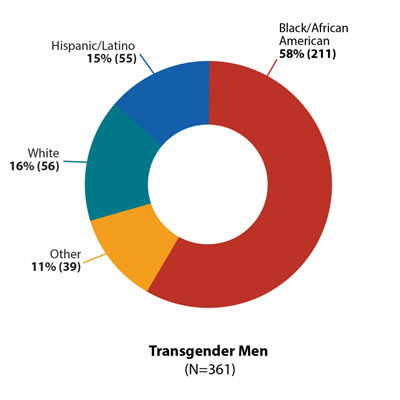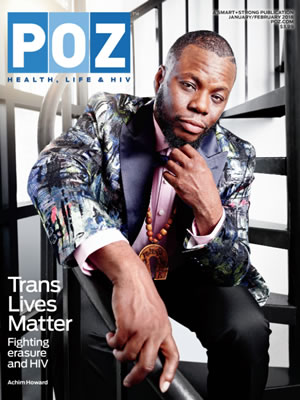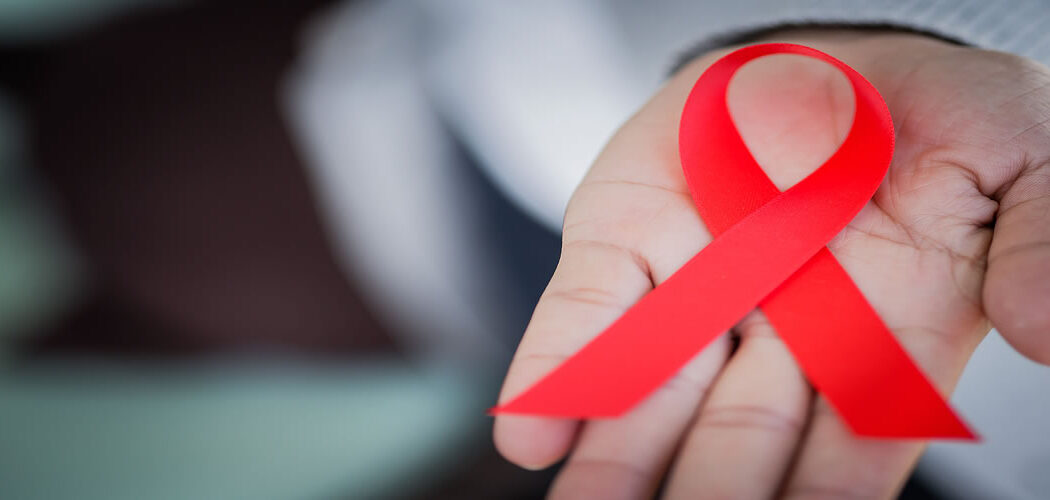April 18th is National Transgender HIV Testing Day, a day to recognize the importance of routine HIV testing, status awareness and continued focus on HIV prevention and treatment efforts among transgender and non-binary people.
Because of gaps in research, not much is known about HIV and transgender men. Trans men have often been absent from HIV studies due to small sample sizes, eligibility criteria, limited research design, or the misconceptions that trans men are mostly heterosexual or are not at risk for HIV.
Transgender People Living with HIV: The Numbers

- A 2017 paper used meta-analysis and synthesized national surveys to estimate that nearly 1 million adults in the United States are transgender.
- From 2009 to 2014, 2,351 transgender people received an HIV diagnosis in the United States.
- Positively Trans Needs Assessment (2016) surveyed 400 transgender people living with HIV and found that 12% identified as FTM/transmasculine spectrum. The 2017 study reported 15%.
- Around half of transgender people (43% of transgender women; 54% of transgender men) who received an HIV diagnosis lived in the South.
- Among the 3 million HIV testing events reported to CDC in 2017, the percentage of transgender people who received a new HIV diagnosis was 3 times the national average.
- Nearly two thirds of transgender women and men surveyed by the Behavioral Risk Factor Surveillance System (BRFSS) in 2014 and 2015 reported never testing for HIV.
Source: HIV and Transgender People
We don’t know much about trans MSM risk for HIV; estimates range from much less than cisgender gay and bi men to somewhat more.
“Although most T-GBMSM were not primarily or exclusively attracted to men, HIV-related sexual risk was higher among those who were, suggesting need for interventions for this subgroup.” — HIV-Related Sexual Risk Among Transgender Men Who Are Gay, Bisexual, or Have Sex With Men
“Many of my trans masculine patients have condom-less penetrative sex with penises so are at risk of HIV infection. Testosterone causes thinning and dryness or vaginal mucosa which increases risk of bleeding and tearing during sex. While there aren’t studies specifically looking at this, I believe trans men may be at higher risk of contracting HIV if exposed to the virus, compared to cisgender women.” – Dr. Jessica Rongitsch, a primary care doctor at Capitol Hill Medical, an LGBTQ clinic in Seattle, Washington has been providing gender affirming care for the trans community for over 15 years.
HIV and Transgender Men: What Do We Know?
- Two-thirds of trans men identify as gay, bisexual, or queer.
- Transgender men’s HIV and PrEP needs are not being met.
- HIV-positive transgender men in the United States have significant unmet social and healthcare needs.
- While transgender men share some HIV acquisition risk factors with their cisgender counterparts, there’s a need for trans-inclusive services and trans-specific education, particularly within services for gay men.
Invisible Men
Mainstream visibility of transgender men living with HIV is virtually nonexistent.
“I would like people to know we exist. That we are gay, straight, bi, and queer just like non trans people with HIV,” says Teo Drake, an HIV-positive, queer trans man who worked on the Positively Trans Needs Assessment. Living with HIV for decades, Drake says it was coming out as trans and living life as a queer man that helped him get healthy.
I know how healing living authentically can be. In 2002, prior to choosing to transition, I had 33 T cells and a viral load above the limits of detection. No treatment worked. The side effects were all too severe, and I didn’t have it in me to fight for a life that wasn’t the one I wanted to be living. I made the decision to transition as a last kindness to myself because I didn’t think I would survive another few years. The paradox is that as I stepped more and more into an authentic expression of my inner self, my health improved. I was able to tolerate the medication side effects because I had the life I finally felt was worth fighting for. Turns out that loving yourself is a powerful healing force.

Achim Howard is at the forefront of the transgender HIV activism. “I became an advocate for trans men living with HIV when I became positive,” Howard says. Along with other HIV-positive trans men of color, Howard founded Trans Men Rising to help educate people. He’s disturbed by the alarming HIV rates in the black community.“It’s getting out of hand,” he laments, fearing efforts to address those disparities will fall short. “It’s hard because there’s limited funding and the current administration is not on any of our sides.”
There’s so much work to be done but the Center for Disease Control and its partners are working hard to maximize the effectiveness of current HIV prevention methods among transgender people. You can find out more about what CDC is doing at the bottom of this page.
Initiatives like National Transgender HIV Testing Day and World AIDS Day remind us of the importance of routine HIV testing, status awareness and continued focus on HIV prevention and treatment efforts among transgender people. If you haven’t been tested in a while, or at all, today’s a great day to take the steps to make that happen!
Resources
Where Can You Get Tested?
You can ask your health care provider for an HIV test. Many medical clinics, substance abuse programs, community health centers, and hospitals offer them too. You can also buy a home testing kit at a pharmacy or online. In the U.S.A., you can also find a testing site near you by: calling 1-800-CDC-INFO (232-4636), visiting gettested.cdc.gov or texting your ZIP code to KNOW IT (566948). Or, enter your ZIP code in the Locator tool below to find a testing site near you.
Transforming Health
While the primary audience of these guides is trans women, they have a lot of information that’s useful for anyone.
- HIV – What You Need To Know
Know Your Status
If You Are HIV-Negative – Staying Healthy and HIV-Negative
What You can Do To Protect Yourself From HIV
If You Are HIV-Positive – Seeking Treatment - Living with HIV: How to Protect Yourself and Others
HIV Treatment: Taking Care of Yourself and Protecting Others
How To Make Your Viral Load Very Low or Undetectable
An HIV Diagnosis Can Be a Life-Changing Event
Status Disclosure: Telling Your Partners and Encouraging Them to Get Tested
Research
- Sexual HIV risk among gay, bisexual and queer transgender men (2017)
- Transmen: the HIV risk of gay identity (2011)
- Transmen in San Francisco: what do we know from HIV test site data? (2011)
Published: 04/18/19. Last updated: 04/18/23


Thank you!